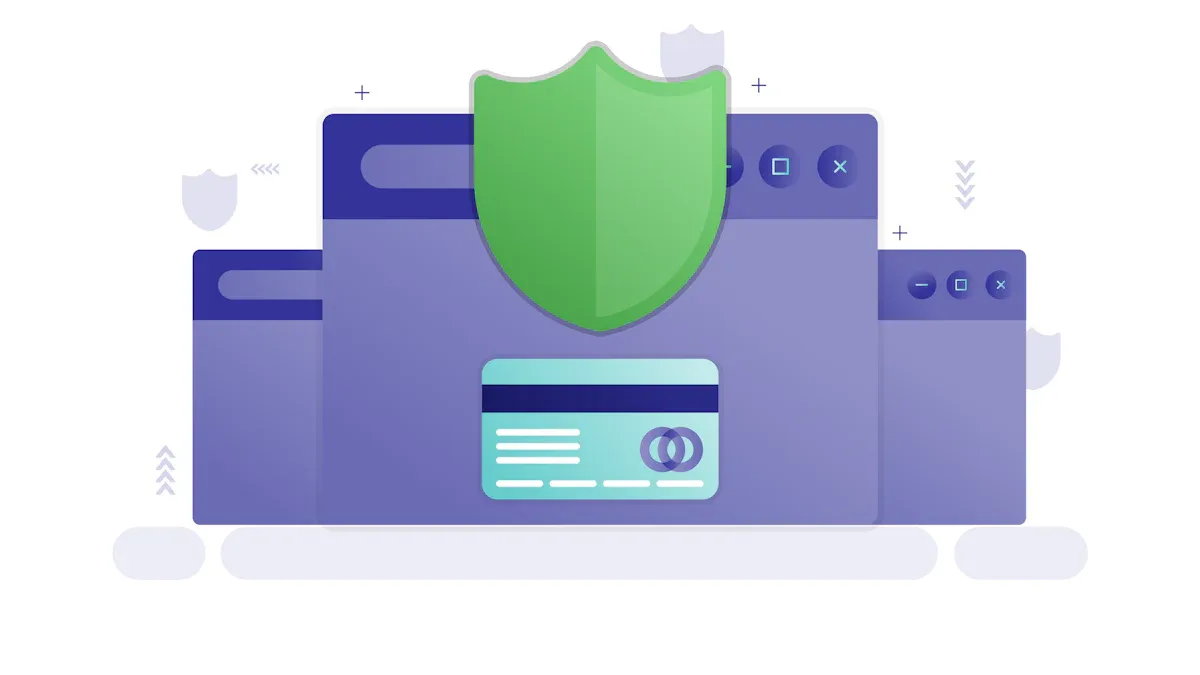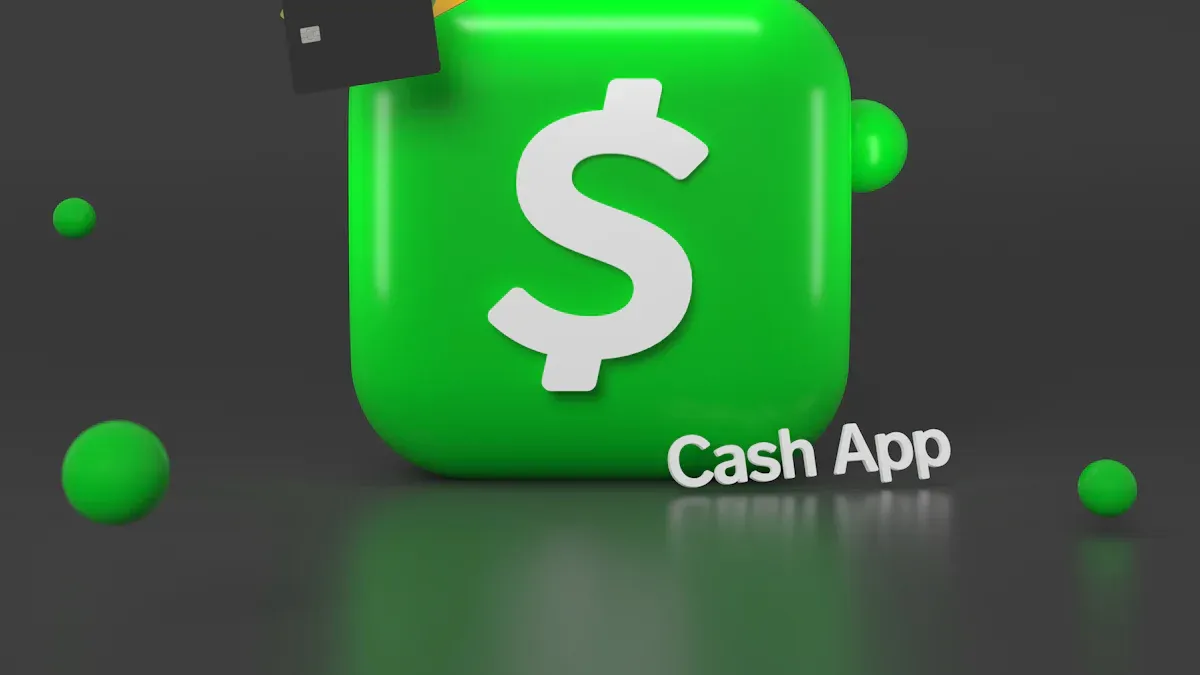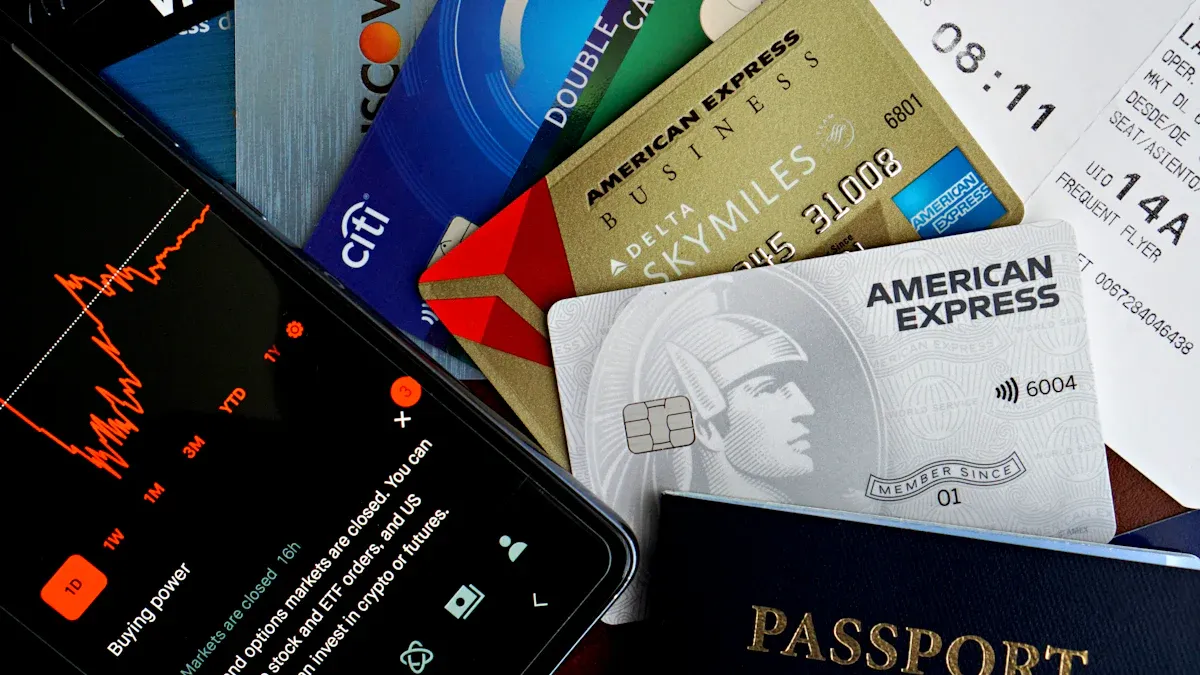- EasyCard
- Trade
- Help
- Announcement
- Academy
- SWIFT Code
- Iban Number
- Referral
- Customer Service
- Blog
- Creator
How can I safely add a credit card to Cash App and recharge it smoothly?

Image Source: unsplash
You may want to use a credit card to top up your Cash App account, but the official policy clearly states that credit cards cannot be used for direct top-ups. However, you can safely add a credit card and use it to pay friends or purchase Bitcoin. Cash App is a highly popular application, especially in the United States:
- Over 70% of users reside in the United States.
- It is projected that by 2025, its US users will reach 54.3 million.
The massive user base makes understanding how to safely add a credit card particularly important.
Key Takeaways
- You cannot directly top up your Cash App account with a credit card, but you can use it to pay friends or make purchases in stores.
- Paying with a credit card on Cash App incurs a 3% handling fee, and banks may treat the transaction as a “cash advance,” which incurs higher fees and interest.
- To protect your account, always enable security locks, real-time transaction notifications, and authorize location services to prevent fraud.
- If you encounter issues, such as a declined credit card, first check the entered information for accuracy, then contact your bank or seek help through official Cash App channels.
- Cash App staff will never ask for your password or verification code, so be wary of scam messages.
Steps to Safely Add a Credit Card to Cash App

Image Source: unsplash
Before starting the process, you need to understand an important prerequisite: completing identity verification (KYC). To comply with financial regulations and unlock all features, Cash App requires identity verification. This step is mandatory if you want to use features like Bitcoin.
What is Identity Verification (KYC)? KYC stands for “Know Your Customer.” You need to provide the following information to complete verification:
- Government-issued valid, valid ID: Such as your driver’s license or passport.
- Social Security Number (SSN): US users must provide the full SSN.
- Clear selfie: Used to compare with the photo on your ID.
After verification, you can not only safely add a credit card but also increase account transaction limits and fully use Bitcoin purchase, send, and receive functions.
Navigate to Payment Methods
First, ensure you have already linked a bank account or debit card. This is a prerequisite for adding a credit card. Then, follow this path to find the payment method settings:
- Open Cash App on your phone.
- Tap the profile icon (Profile Icon) in the top-left corner of the home screen.
- Scroll down the menu and tap “Linked Banks” or the “Funds” option.
This interface will display all your linked payment methods.
Select Add Credit Card
On the payment methods page, you will see the linked bank accounts or debit cards. Below this list, you will find a clear option.
- Directly tap the “Add Credit Card” button.
This action will take you to the information entry page, preparing you for the final step.
Enter and Verify Information
This is the most critical step in the process of safely adding a credit card; you must enter the information accurately and pay close attention to the security of your operating environment.
Follow the on-screen prompts and enter the following information in order:
- Your credit card number (16 digits)
- Credit card expiration date (month/year)
- CVV security code on the back of the card (usually 3 digits)
- Billing ZIP code associated with the credit card
Security Alert: Never Use Public Wi-Fi! Entering credit card information while connected to public Wi-Fi in places like cafes, airports, or hotels puts your personal data at significant risk. Hackers can easily intercept your sensitive information over unsecured networks.
| Public Wi-Fi Threats | Meaning | Potential Consequences |
|---|---|---|
| Data Interception | Hackers intercept your data on unsecured networks. | Credit card numbers and login credentials stolen. |
| Fake Wi-Fi Hotspots | Criminals set up fake networks to lure you into connecting. | Leads to financial fraud or identity theft. |
| Malware Injection | Hackers install malware on your device via the network. | Device compromised, personal data stolen. |
To protect your assets, always operate on a trusted private Wi-Fi network or use your mobile data network.
After entering all information and confirming accuracy, tap the “Add Card” button. Cash App will verify your credit card details, and upon success, your credit card will appear in the “Linked Banks” list.
Fees and Uses for Credit Card Payments

Image Source: pexels
After successfully linking a credit card to your Cash App account, you unlock a new payment option. However, this convenience is not free. Before using a credit card for payments, you must clearly understand the associated fees and potential risks to avoid unexpected high bills.
Transaction Fees
The most direct cost of using a credit card for payments on Cash App is the handling fee. Unlike using a debit card or bank account, credit card transactions incur additional charges.
| Transaction Type | Fee |
|---|---|
| Sending payment from a credit card | 3% |
This means that if you send $100 to a friend using a credit card, Cash App will charge you a $3 fee, and the total amount you pay will be $103.
Serious Warning: Beware of the “Cash Advance” Trap!
You need to be especially cautious, as many credit card issuers treat transfers to individuals via Cash App as “cash advances” rather than regular purchases. This triggers a series of high fees and interest:
- Higher interest rates: Cash advance APRs are typically much higher than purchase rates, sometimes nearing 30%.
- Additional fees: Issuers charge a cash advance fee, usually 3% to 5% of the transaction amount, or a minimum fee, such as “$10 or 5%, whichever is greater”. This means even a small transfer could incur a $10 fixed fee.
- No grace period: Unlike purchases, cash advance interest starts accruing from the transaction date, with no interest-free repayment period.
For example, a $400 credit card transfer treated as a cash advance could incur Cash App’s 3% fee plus an immediate $20 advance fee from the bank (5%), and interest at up to 30% APR starts immediately.
In contrast, if you have a Cash App business account, the platform charges 2.75% for receiving customer payments.
Choose Payment Method
When preparing to pay someone, Cash App allows you to freely select the funding source. After completing the steps to safely add a credit card, it becomes an available payment option.
The process is very simple:
- Enter the amount on the Cash App home screen, then tap “Pay”.
- Select a recipient.
- At the top of the payment confirmation page, you will see the current payment source (e.g., your Cash App balance or debit card).
- Tap this payment source to open a list of all linked accounts.
- Select your credit card from the list.
Before selecting, confirm again: using a debit card or bank account is usually free, while choosing a credit card means paying a 3% fee and risking cash advance charges.
Other Payment Scenarios
Although you cannot top up your Cash App balance with a credit card, it remains useful in other payment scenarios. However, some features have strict payment method restrictions.
A common question is whether you can buy Bitcoin with a credit card. The answer is no. According to Cash App policy, you can only use your Cash App balance, linked bank account, or debit card to purchase Bitcoin. Neither the platform nor credit card companies allow direct use of credit cards for such investments.
However, you can use a linked credit card to pay online merchants or physical stores that accept Cash App Pay. In such cases, the transaction is usually treated as a regular purchase, but you should still check for additional fees from the merchant or Cash App. Developing a habit of confirming payment terms before each transaction is a key step to protecting your financial security.
Core Tips to Enhance Account Security
After successfully adding a credit card, your primary task is to proactively reinforce your account’s “security door.” Cash App provides multiple powerful tools in the “Privacy & Security” settings that you can use to build a robust defense system and protect your funds.
Enable Security Lock (PIN/Biometric)
This is the first line of defense you must activate. After enabling the Security Lock feature, every payment requires additional authorization.
Depending on your phone model, you can set:
- PIN code: A unique code exclusive to your Cash App account.
- Biometric ID: Convenient and secure Face ID or Touch ID.
Activating this feature means that even if someone accesses your unlocked phone, they cannot transfer a single cent without your PIN or biometric data.
Enable Real-Time Transaction Notifications
You should immediately turn on real-time notifications for all transactions. Whether via email or push notifications, this feature alerts you the moment a transaction occurs. If you spot any suspicious activity not initiated by you, you can detect and respond immediately to minimize potential losses.
Authorize Location Services for Fraud Prevention
You may hesitate to grant location access to an app, but in Cash App, it is an effective anti-fraud tool. Cash App uses “unusual location signals” to identify suspicious activity. For example, if your account suddenly initiates a transaction in an unfamiliar country or city, the system may automatically pause the transaction and require additional verification. This layer of protection effectively prevents remote theft.
Regularly Review Transaction History
Developing a habit of regularly checking transaction history is crucial. You can view all records through these simple steps:
- Open Cash App.
- Tap the clock icon (Activity) in the bottom-right corner of the home screen.
- Here, you can scroll through all payment and receipt records.
During review, stay vigilant for any unfamiliar transactions.
Scam Alert: Official Staff Will Never Request Sensitive Information! Scammers often impersonate Cash App support, contacting you via email, text, or phone, claiming “unusual activity” or needing “verification.” Their ultimate goal is to steal your login credentials or PIN.
Remember: Cash App official support will never request your PIN, login verification code, or full bank card details. Anyone proactively contacting you and asking for this information is a scammer.
Common Issues and Contacting Support
Even if you follow the steps perfectly, you may encounter issues, such as a declined credit card. Understanding how to resolve these common problems and how to safely contact official support is the final key defense for securing your account and user experience.
What to Do If Your Credit Card Is Declined
When adding a credit card fails, don’t panic. This is usually caused by simple issues. You can troubleshoot using the following checklist:
- Check card information: Confirm the 16-digit card number, expiration date (MM/YY), and CVV security code are completely correct. An expired card cannot be added.
- Verify billing address: Ensure the billing ZIP code you entered matches the address on file with the issuer.
- Confirm account verification: Unverified (KYC incomplete) accounts have limited functionality and may fail to add payment methods. Check verification status in the “Security & Privacy” section of the app.
- Contact your issuer: If all information is correct, the issue likely lies with the bank. The bank’s risk control system may flag adding a card to Cash App as suspicious and block it. Call your bank to authorize the operation.
Most Common Causes Most credit card decline issues stem from:
- Information mismatch: Card number, expiration, CVV, or billing address does not match bank records.
- Bank security block: The bank proactively rejects authorization to a third-party payment platform for security reasons.
How to Contact Official Support
When you encounter issues you cannot resolve yourself, contacting official support is the right choice. However, the internet is full of scam phone numbers impersonating Cash App support, so you must use the only correct channel.
Strictly follow these steps to contact the support team within the app:
- Open Cash App on your phone.
- Tap the profile icon in the top-left corner of the home screen.
- Scroll down and tap “Support”.
- Select a topic related to your issue, then tap “Contact Support”.
After sending a message through this channel, you will receive a response from the official team within a few hours.
Security Warning: Protect Your Login Credentials! Scammers will go to great lengths to obtain your sensitive information. Remember, Cash App official support will never request the following via any channel:
Anyone proactively contacting you and asking for this information is a scammer. Never trust customer service phone numbers found through online searches.
You now understand that credit cards cannot top up your Cash App balance, but they remain a convenient payment method. Always beware of the 3% transaction fee and potential high “cash advance” interest. Financial security is paramount, and we recommend immediately enabling security locks and transaction notifications.
Final Recommendation: Completing the steps to safely add a credit card is just the first step. Developing a habit of confirming fees and payment methods before each transaction minimizes risk.
FAQ
Can I top up Cash App with a credit card?
You cannot top up your Cash App balance with a credit card. Credit cards can only be used to pay others or merchants. To top up, use a linked debit card or bank account.
Why is there a 3% fee for paying with a credit card?
Cash App charges this fee to cover the cost of processing credit card transactions. Credit card companies charge the platform a service fee, part of which is passed on to you. In contrast, using a debit card or bank account is usually free.
Can I remove a linked credit card?
Yes, you can remove an unused credit card at any time. The steps are very simple:
- Go to the “Linked Banks” (Funds) page in your profile.
- Select the credit card you want to remove.
- Tap “Remove Card” and confirm.
*This article is provided for general information purposes and does not constitute legal, tax or other professional advice from BiyaPay or its subsidiaries and its affiliates, and it is not intended as a substitute for obtaining advice from a financial advisor or any other professional.
We make no representations, warranties or warranties, express or implied, as to the accuracy, completeness or timeliness of the contents of this publication.




Contact Us
Company and Team
BiyaPay Products
Customer Services
is a broker-dealer registered with the U.S. Securities and Exchange Commission (SEC) (No.: 802-127417), member of the Financial Industry Regulatory Authority (FINRA) (CRD: 325027), member of the Securities Investor Protection Corporation (SIPC), and regulated by FINRA and SEC.
registered with the US Financial Crimes Enforcement Network (FinCEN), as a Money Services Business (MSB), registration number: 31000218637349, and regulated by FinCEN.
registered as Financial Service Provider (FSP number: FSP1007221) in New Zealand, and is a member of the Financial Dispute Resolution Scheme, a New Zealand independent dispute resolution service provider.




















